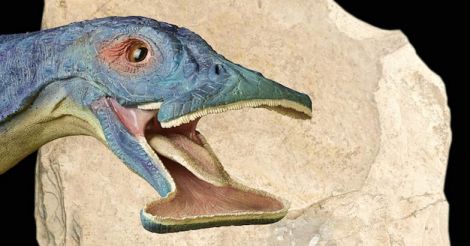A bizarre crocodile-sized 'hammerhead' creature, that lived 242 million years ago in what today is southern China, may have been the earliest known example of a plant-eating marine reptile, scientists say.
The fossil, discovered in 2014, has a poorly preserved head, but it seemed to have a flamingo-like beak.
Scientists found that "beak" is actually part of a hammerhead-shaped jaw apparatus, which it used to feed on plants on the ocean floor.
"It's a very strange animal. It's got a hammerhead, which is unique, it's the first time we've seen a reptile like this," said Olivier Rieppel, from The Field Museum in Chicago.
The reptile's name, Atopodentatus unicus, hints at its muddled past - it is Latin for "unique strangely toothed."
However, newly discovered fossils make it clearer how its "strange teeth" were actually configured. Its wide jaw was shaped like a hammerhead, and along the edge, it had peg-like teeth.
Then, further into its mouth, it had bunches of needle-like teeth, researchers said.
"To figure out how the jaw fit together and how the animal actually fed, we bought some children's clay and rebuilt it with toothpicks to represent the teeth," said Rieppel.
"We looked at how the upper and lower jaw locked together, and that's how we proceeded and described it," he said.
“Atopodentatus unicus used its bizarre jaw to help it eat plants,” researchers said.
"It used the peg-like front teeth to scrape plants off of rocks on the sea floor, and then it opened its mouth and sucked in the bits of plant material," Rieppel said.
"Then, it used its needle-like teeth as a sieve, trapping the plants and letting the water back out, like how whales filter-feed with their baleen," he said.
Not only does this discovery solve the mystery of the strange-toothed animal, but it also provides us with an example of the first herbivorous marine reptile.
"The jaw structure is clearly that of an herbivore. It has similarities to other marine animals that ate plants with a filter-feeding system, but Atopodentatus is older than them by about eight million years," said Rieppel.
Atopodentatus also helps tell a bigger story about the world's largest mass extinction 252 million years ago, researchers said.
"Animals living the years surrounding the Permian-Triassic extinction help us see how life on earth reacted to that event," said Rieppel.
"The existence of specialised animals like Atopodentatus unicus shows us that life recovered and diversified more quickly than previously thought," he said.
(With agency inputs)
























 The reptile's name, Atopodentatus unicus, hints at its muddled past - it is Latin for "unique strangely toothed."
The reptile's name, Atopodentatus unicus, hints at its muddled past - it is Latin for "unique strangely toothed."